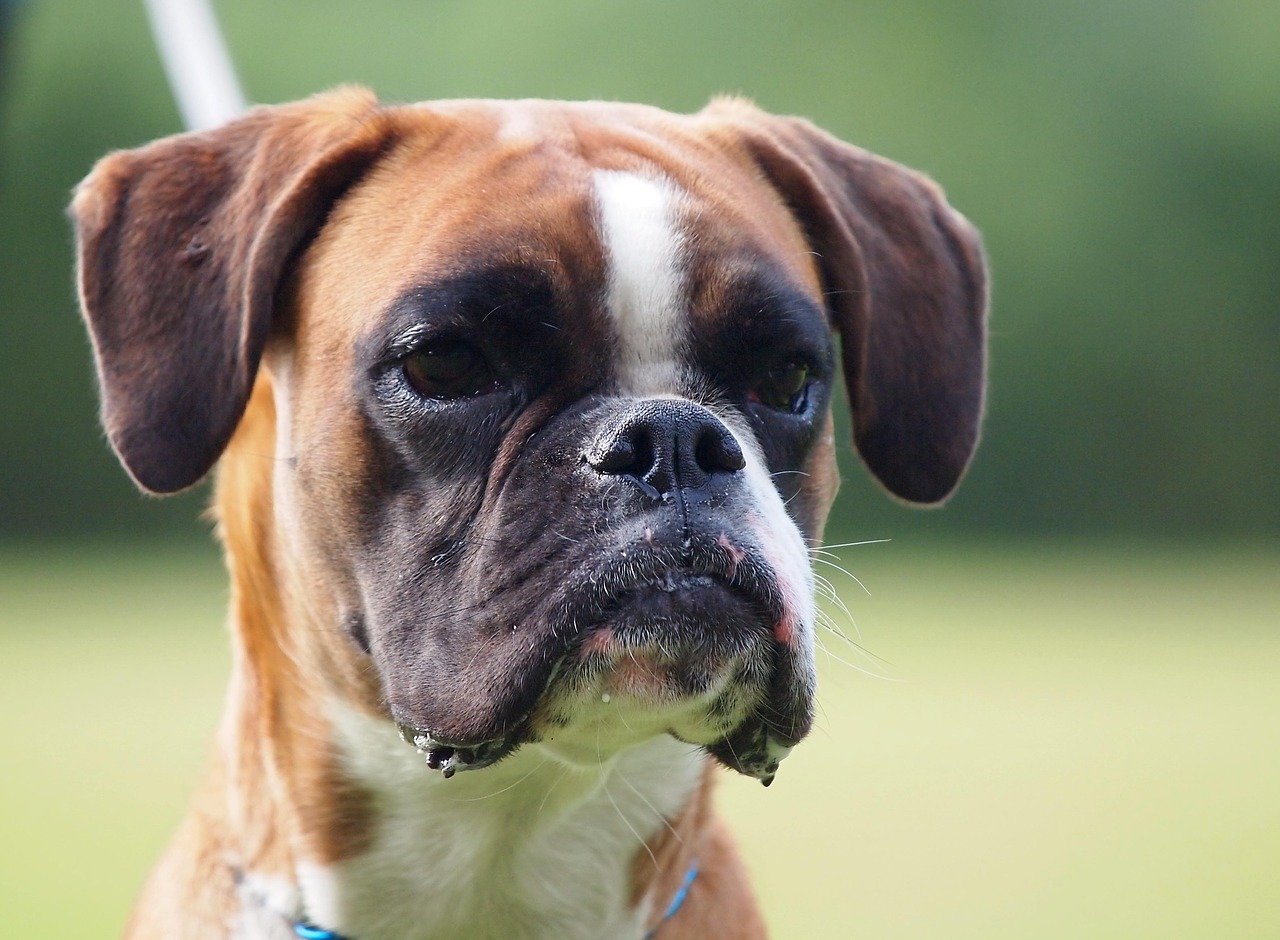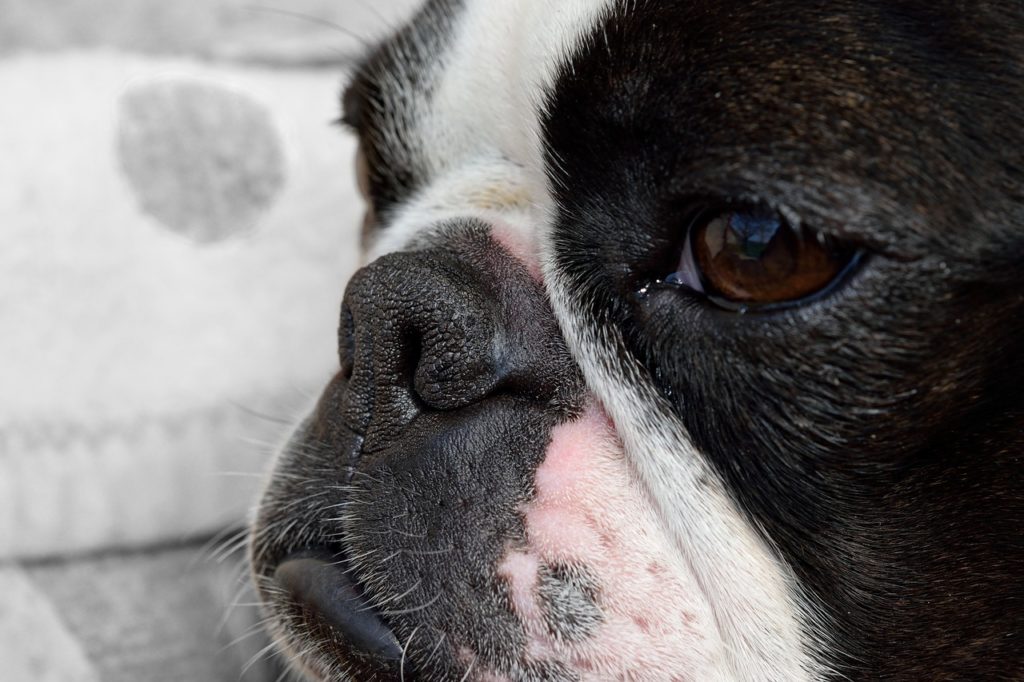
The Boxer is classified as one of the Working Dog Breeds in the American Kennel Club. They typically stand up to two feet tall and weigh in around 65 pounds. If the Boxer is taken care of properly then he is very likely to live up to 12 years old. Boxers are a fun-loving, humorous and loyal dog breed that could fit nicely in your family dynamic.
History of the Boxer
The Boxer was the result of mix breeding the Bulldog with the German Bullenbeisser. The German Bullenbeisser is well-known for his hunting abilities and would often be used to take down bears, wild boar, as well as deer. These dogs were later used as guard dogs and cattle herders. These qualities were then passed down to the Boxer.

The Boxer is believed to have originated in the 19th century with a dog by the name of Lechner’s Box. Lechner’s Box was fawn and white in color, and his mother was a female German Bullenbeisser named Flora (his father is unknown).
Lechner’s Box was then used to begin the cross breeding process that would span various generations of dogs. Eventually, a female pup was born and named Meta von der Passage. She was white in color and hardly resembled the modern day Boxer. However, she is referred to as the mother of the Boxer dog breed. She became well-known for producing puppies of “marvelous type and rare quality.”
The Boxer dog breed needed to be stabilized (1894) and eventually entered into a dog show by three Germans (Roberth, Hopner, and Konig) in 1895. By 1896 the Boxer dog breed had their own club, The Boxer Club. In the early 1900’s Boxers were being imported to the United States and accepted as members of the American Kennel Club officially in 1904.
However, there would not be a Boxer champion until the year 1915. Boxer dogs were enlisted to serve the military during World War I. It was their responsibility to transport messages, carry packs, as well as serve as guard and attack dogs (when necessary). After World War II, soldiers and their Boxer companions returned home together which increased the breed’s popularity in homes across the country. The breed quickly became a regular show dog, guard dog and most of all a loving family companion!
The ABC or the American Boxer Club was officially formed and accepted by the American Kennel Club in 1935. However, the clubs had difficulty agreeing on the Boxer breed standard. Finally, in 1938, the Boxer breed had an approved standard. These standards were later revised in the year 2005. Boxer Dogs are ranked in the top ten canine breeds that are members of the American Kennel Club.
Personality and Temperament of the Boxer
The Boxer dog breed has a personality all his own! He is commonly described as an alert guard dog with a class clown split personality. Boxers are very watchful, protective and confident. They are not afraid to inform their owners of an intruder or potentially dangerous situation. They are typically very accepting of non-threatening strangers, and they will likely welcome them warmly into their home.

Boxers are also a very polite dog breed and will display a friendly demeanor most of the time. However, Boxers can become aggressive if he is defending his territory, home, self or family. These pups make excellent family companions because they love children and could spend hours playing with them. They are also a very patient dog breed which is essential when it comes to small children. They are well-known for clowning around and doing almost anything for a laugh!
A combination of factors often determines the Boxer temperament. Genetic makeup, training, and of course, socialization. Boxer puppies should display curiosity and playfulness as well as a love of people. It is best to observe all of the puppies closely before choosing one to adopt. A Boxer puppy that is timid or fearful of people may have a difficult time adjusting to a new environment. While this is not necessarily a “deal breaker” for choosing to adopt the puppy, it just means that the adopter should be prepared for more in-depth training, socialization as well as one of one time with the puppy at home.
Caring for the Boxer
Feeding
Boxers should be fed up to three cups of high-quality dog kibble each day. It is best if this quantity is divided into two separate feeding times during the day (i.e. breakfast and dinner). They should be fed a kibble that is formulated for their age, size, and activity level. Boxer owners should avoid overfeeding their canine as it will quickly lead to health conditions including obesity in their dog.
Exercise
Proper exercise on a daily basis is another way to avoid obesity in our Boxer buddies. They should be walked around the neighborhood, on a leash, at least once a day. Boxers do not make the best running companions as they have a shortened muzzle and will, therefore, have a difficult time breathing at a fast pace.

He is better suited for games of fetch, Frisbee, tug of war and fly ball. They are a very playful dog breed, and they will need plenty of it in order to tire them out. A bored Boxer is a destructive Boxer.
Habitat Requirements
Boxers tend to be a medium to large sized dog and therefore he would be better suited for a single family home rather than an apartment. His tendency to bark at “intruders” would also become an issue in an apartment complex.
Boxers should also have a home with easy access to green space. While this applies to all dog breeds, it applies in particular to the Boxer because he can be difficult to house train. If he is an apartment dweller, then house training could be increasingly difficult. However, if he lives in a home with a fenced in backyard, then house training could be much easier.
Overall, Boxers do very well in homes with children and other animals. It is important to mention that Boxers are a very active dog breed and may be too energetic for infants and toddlers. They are better playmates for older children. If the Boxer is raised alongside the family cat or another dog, then he will most likely be very fond of them!
Training and Barking
Boxers should begin their training sessions during early puppyhood. They should also be socialized early on and regularly throughout the course of their lives. It is critical for the pups to be exposed to a variety of sounds, smells, people, and new experiences.
Puppies will need to undergo house training as well as learn how to follow basic commands before they are full-grown adults. Once the pup has become an adult, he will be more stubborn and thus harder to teach. Proper training and socialization will ensure that he grows up to be an outgoing, well-mannered adult dog. Boxers should also be exposed to crate training at an early age.
Boxer dogs may have a tendency to bark as a result of their guard dog personality. They are likely to bark in an attempt to alert their owners of a dangerous situation or an approaching intruder. Barking without cause should be prevented with the help of early training sessions.
Grooming
Boxer dogs require minimal grooming. They are generally very clean dogs and have even been known to clean themselves similarly to the way cats do. However, there are basic grooming tasks that should not be ignored. One of which is weekly brushing. Regular brushing with a gentle brush will help reduce the amount of fur on your furniture.
Bathing a Boxer should be done whenever he is dirty or smelly. His teeth should regularly be brushed to prevent tartar buildup. His nails should be trimmed monthly to prevent overgrowth and pain. His ears should be checked and cleaned by a professional regular to avoid mites, infections or wax buildup. Finally, a Boxer’s eyes should be clear of discharge and other gunk, and they should not be any redness.
10 Fun Facts about the Boxer
1. Boxers greet their humans with great enthusiasm!
2. Boxers do not do well as “outdoor” dogs. This means that they should spend their time split between the indoors and the outdoors. Their short muzzles make breathing difficult in hot climates, and their short fur coats make them unsuitable for long periods of outdoor time in cold climates.
3. Boxers tend to act like their clownish pupy selves well into their adult years.
4. Boxer dogs tend to be dependent on family activities and quality family time. Without sufficient time with their families, Boxers can become destructive.
5. Boxers can be heavy droolers (especially in warm climates).
6. They have one of the loudest snores of the canine world.
7. Boxers are brilliant dogs! They are able to retain information well. However, they can have a stubborn and independent side which could make training difficult. Owners should try making their training sessions fun!
8. Every Boxer is different. However, most of them will lean towards one of two categories. The first category is Boxer dogs that take their guard dog responsibilities very seriously, too seriously. The second category is Boxer dogs that would rather be the life of the party than performing his watchdog duties.
9. Boxers (and all dogs) should be adopted from a rescue shelter or a reputable breeder. No dog should ever be purchased from a puppy mill.
10. Boxers are very friendly, loving and loyal dogs. If you treat them with love and compassion, then they will surely give it right back!
What do you love about the Boxer Breed?
Comment Below





